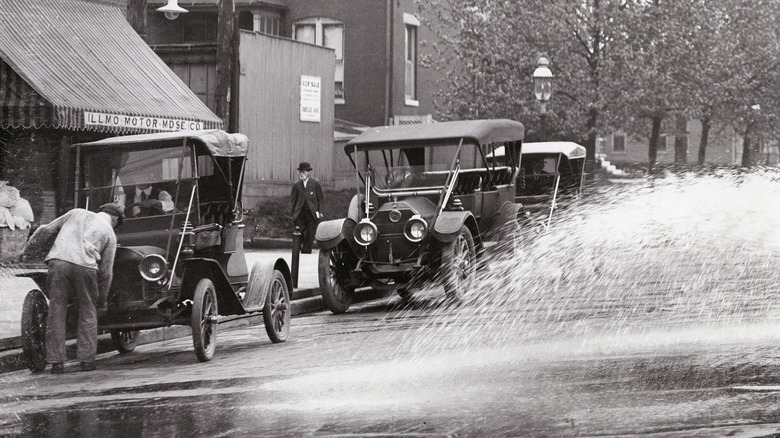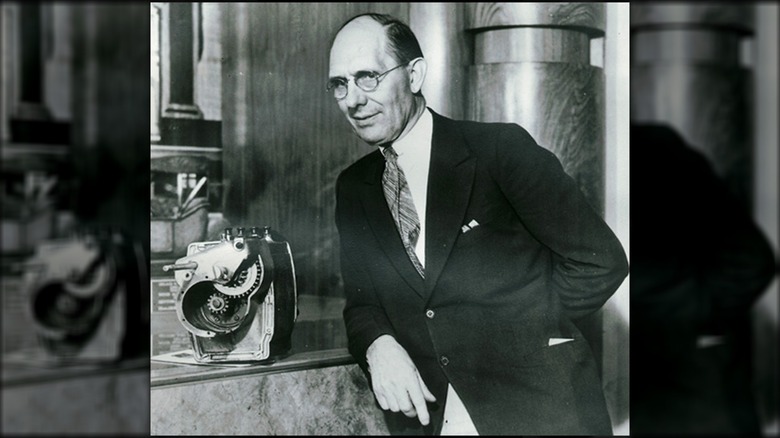Could Crank-Starting An Antique Car Really Break Your Arm?
Thank you, H.J. Dowsing, Clyde J. Coleman, and Charles Franklin Kettering. If those names don't ring a bell, you're probably not a car enthusiast, and even then, you'd have to be a hardcore car nut (or historian) to know who these men were.
Today's cars are fitted with an array of automatic features and adaptive driver assistance systems, so it might be hard to imagine a time when automobiles were really nothing more than a metal brick on wheels. You couldn't simply hop in, turn the key, and go about your merry way. If the 80s catchphrase "Whatcha talkin' bout Willis?" just popped into your noggin, congrats, you know your pop culture.
Seriously, though, up until Kettering's invention in 1911, people had to run through a checklist of things just to make the car move. Imagine heading out for a night on the town with your beau on your arm. You're in your finest attire and looking sharp.
Instead of simply sliding into the driver's seat and pushing a button or — perish the thought — turning a key, you had to stroll up to the front of the vehicle, insert a rusty metal bar into a notch hole in the radiator, and crank away on it vigorously, hoping to fire up the engine on the first go without sustaining any serious injuries. This procedure was more dangerous than you might think, and could result in serious injury — or even death.
[Featured image by Missouri History Museum via Wikimedia Commons | Cropped and scaled | CC BY Public Domain]
Don't yank the crank!
Not only was this chore physically taxing (especially as engines got bigger and gained more compression), but if not done correctly or there was a misfire, it was as likely to get you a broken bone as start the motor. Yes, really.
H.J. Dowsing, a British electrical engineer, is regarded as the first person to attach a rudimentary electric starter (a dynamotor coupled to the flywheel) to a car, while Clyde J. Coleman was the first to successfully receive a patent in America for a fully fleshed out electric automobile starter.
He promptly sold his invention to the Dayton Engineering Laboratories Company (aka Delco), which was owned by Kettering, who invented a number of electrical-based car components, including an ignition system and the first useful engine-driven generator. He also tweaked Coleman's starter design, which would go on to become the first self-starting ignition installed in an automobile (a Cadillac).
All of this took place around the dawn of the 20th century when automobiles like the 1901 Curved Dash Oldsmobile and the 1908 Tin Lizzie (aka the Ford Model T) were early examples of vehicle mass production.
Even though Kettering's invention hit the roads in 1911, hand cranks remained part and parcel of most vehicles on the road until the early 1920s. Believe it or not, some European car makers used hand cranks into the 1990s (including the French Citroen 2CV and the Russian-made Lada Niva).
[Featured image by Unknown via Wikimedia Commons | Cropped and scaled | CC BY Public Domain]
Cranker beware
Until the electric starter arrived on the scene, hand cranking an engine was the leading cause of automobile-related injuries. It was during this time that the medical term "Chauffeur's Fracture" first originated. A slip of the hand, an engine misfire, or some other stroke of bad luck could easily cause the crank to hit the back of the driver's wrist with such great force as to cause a fracture. It was also known to break arms and, in some cases, hit the jaw or head.
In fact, one such incident directly led to Cadillac's decision to do away with the crank levers and install electric starters in the first place.
In 1908, Byron Carter, a friend of Cadillac founder Henry Leland, was playing good Samaritan for a motorist whose Cadillac had broken down. Unbeknownst to him, the driver had failed to adjust the spark — one of many settings that needed adjusting to make the car run smoothly.
When Carter tried to start the vehicle, the engine backfired, causing the crank handle to strike and break his jaw. He subsequently caught pneumonia and eventually died from complications stemming from that initial broken jaw. Leland was so distraught that he swore his cars would never kill another person and set Kettering towards his destiny.

